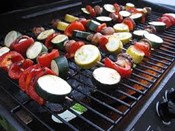Want to add some adventure and nutrition to your grilled meals? Grill vegetables and fruits.
Here are some great facts and tips to motivate you to try grilled veggies and fruits:
- Fruits and veggies are nutrient dense, low in calories and high in fiber, antioxidants and phytochemicals and also may reduce our risk of a heart attack or stroke. An added bonus is that potentially dangerous carcinogens don’t form when grilling fruits and veggies, which can happen can when grilling meat.
- The average bite of food travels 1300 miles, according to the Food Awareness Project. Fruits and vegetables do lose some nutritional value when they are transported and stored before reaching the grocery store. The bonus of an early spring is that farmers’ markets, which offer an option to buy local and support the economy, may open early.
- Is organic produce is a healthier, more nutritious choice than conventionally grown produce? Research is inconclusive. Choose what you’re comfortable with and what you can afford -- just eat more veggies and fruits more often.
- Grilling vegetables isn’t an exact science: veggies don’t all cook for the same length of time. Watch them closely so they don’t overcook or burn. Experiment with settings on your grill, but veggies and fruits generally cook at a lower temp than you would use to grill meat. Size matters; smaller pieces will cook more quickly than larger ones.
- When grilling vegetables avoid cross contamination with raw meat. Use separate tongs and plates and temper the grill surface to medium to medium-high heat before adding raw produce.
- Drizzle low-water content veggies like baby or whole carrots, mushrooms, asparagus and summer squash with oil so they won’t stick before laying them directly on the grill. If you’re cooking smaller chunks, use a grilling tray or thread a colorful combo on skewers.
- Try veggies you normally don’t like. If eggplant, pepper or zucchini aren’t favorites, for example, grilling them may change their taste enough that you enjoy them. Drizzle these fresh grilled veggies with balsamic vinegar. It tastes great with the smoky flavor from the grill.
- Marinades can offer a nice flavor change to veggies, but remember that marinades with added sugar will cause the veggies to blacken.
- Combine corn on the cob cut into 2-inch chunks, sweet potato slices and onion wedges brushed with oil on a perforated grilling pan and grill until the veggies are tender. Or use the grill to steam white or sweet potatoes in thick slices sprinkled with olive oil, your favorite herbs and a dash of salt in foil packets. Flip the packets half way through cooking. The grill temperature and thickness of the potatoes will determine how long to cook them, but a good rule of thumb is to check them after 30 minutes.
- Lightly score the cap of portabella mushrooms in the shape of an “x” to permit some of the moisture to escape. Drizzle the underside with a little olive oil and herbs and then grill them cap side down on foil for about 10 minutes. Sprinkle them with cheese to add protein and flavor and eat as a sandwich or part of a meal.
-Use leftover grilled veggies, which keep well for up to 3 days when wrapped and refrigerated, in sandwiches, over cooked rice or couscous, or mixed into a salad or pasta salad.
- Desserts are easy on the grill. The grill caramelizes sugar in fruit and releases juices. Firm fruits like apples, pineapple and pears require less monitoring than softer fruits such as nectarines, peaches and bananas, which cook quickly. Cut stone and seeded fruits in half and then remove the pit or core and brush them with oil so they won’t stick to the grill. Grill them until they are heated through and a golden color. After grilling fruits, sprinkle them with cinnamon or add a touch of whipped cream or low fat ice cream or yogurt. You can also use grilled fruit to make fruit salsas or serve fruit as a side dish to meats.
Source: www.extension.org; Colorado State University







